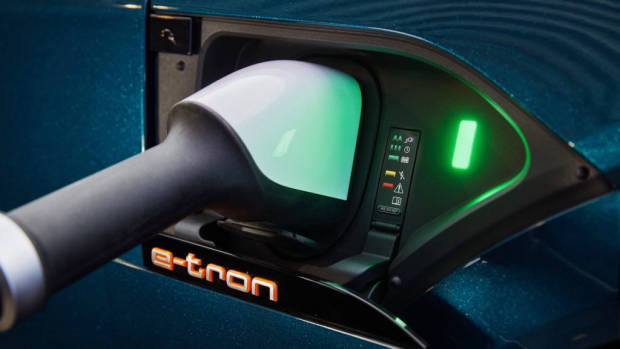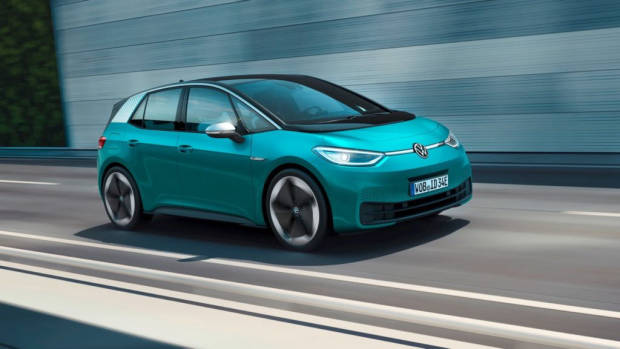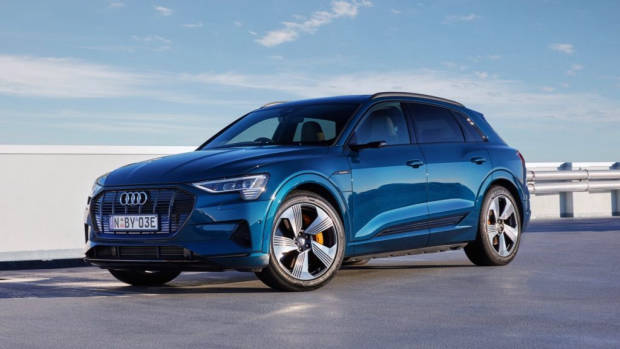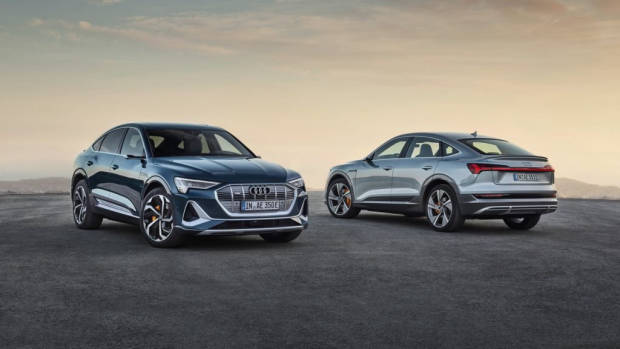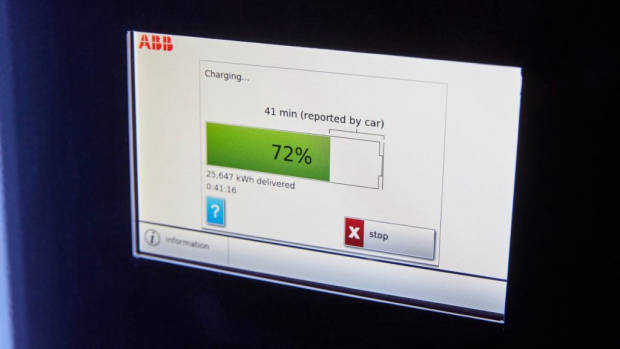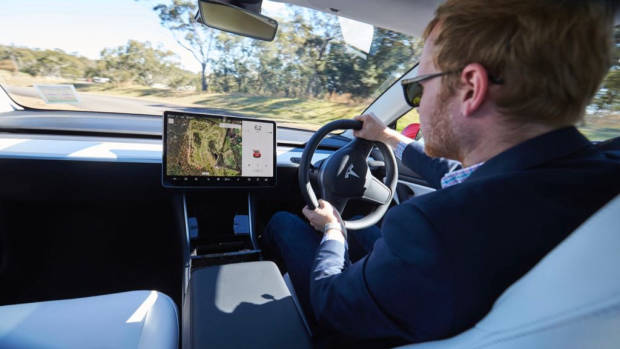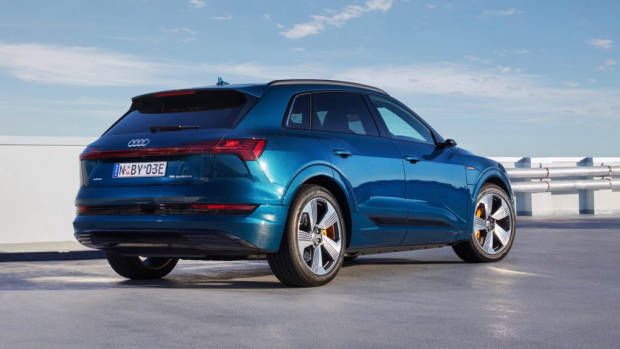-
Car Reviews
- All reviews
- Midsize SUVs
- Small cars
- Utes
- Small SUVs
- Large SUVs
- Large cars
- Sports SUVs
- Sports cars
- Vans
Latest reviews
- Car News
-
Car Comparisons
Latest comparisons
- Chasing Deals
The arrival of Audi’s e-tron SUV lineup – the German marque’s first full-electric vehicles – blows the starting whistle on Audi Australia’s managing director Paul Sansom’s claim that 45% of the Audi global sales will be electric by 2025.
With the e-tron and e-tron Sportback, which arrive in Australia in September, Mr Sansom suggested that this style of vehicle will “reset the benchmark for premium mobility”. To us, that sounds like the SUV form factor will remain prevalent, which makes pragmatic sense for EVs: the high ride height creates space for a ‘skateboard’ packaging of batteries while realising greater passenger comfort.
Audi’s future target doesn’t just consist of pure EVs like the teased Q4 e-tron SUV and the forthcoming, lower-slung e-tron GT four-door: instead, this figure will be undoubtedly complemented by PHEV variants of current production vehicles in the vein of the BMW X5 xDrive 45e. Previously, Audi sold mild plug-in hybrid versions of the Q7 SUV and A3 hatchback in Australia, but the present lineup here is combustion-only.
Overseas, Audi sells a broad range of plug-in hybrids to complement its growing range of full-electric vehicles. Badged TFSI e, hybrid versions are offered on the Q5, A7 and A8, among other cars. The Q5 55 TFSI e teams a two-litre turbo petrol engine with a 14.1kWh battery, providing around 40 kilometres of pure-electric range for commuting.
Audi communications manager Shaun Cleary indicated plug-in hybrids were being assessed for the Australian market. “We’re still assessing exactly how those models might form part of our line-up”, Mr Cleary said.
The arrival of the e-tron full-electric SUVs will provide substantially better zero tailpipe emission usability than that. The entry-level, $137k e-tron 50 promises a range of around 300km, with the pricier $146k e-tron 55 boosting the distance to about 400km.
The eventual supplementary target for Audi is thirty models with some form of electric propulsion above and beyond the current 48-volt mild-hybrid tech currently found in many recent Audi vehicles.
With platform sharing we know Audi can lean on the learnings of Volkswagen and Porsche, using underpinnings of vehicles like the coming VW ID.3 at the affordable end, and powerhouse Porsche Taycan at the pointier to bolster the electric range.
Audi isn’t facing the tough climb to a transition to EV motoring alone. Like mainstream player Hyundai, Audi has opted to partner with the Chargefox fast-charging network to offer Australian customers an easy public charging solution. Like Tesla, Audi’s navigation system is smart enough to calculate the ideal route for electric vehicles, including estimated charge-times.
Not every EV is created equal, so what exactly is Audi doing differently, and what have they learnt from their rather public prototyping under the R8 e-tron and the three-time Le Mans winning R18 TDI.
Already the e-tron is capable of fast-charging equalling the 150kW capacity of Tesla’s V2 Supercharger V2. Matthew Dale, product planning manager for the e-tron project, suggested we’ll be seeing cars with four rings capable of 350kW fast-charging very soon. Charging at 150kW replenishes the e-tron 55’s battery to 80% – or 320km of range – in about half an hour. Should future Audis be capable of 350kW charging, this would allow charging to 80% in about ten minutes.
Another intelligent solution from the Germans includes battery technology that allows 100% charge to be achieved in a more timely manner – something that has hindered many other manufacturers.
Talking figures, the e-tron 55 will take 30 minutes to reach 80% charge for its 95kWh battery when using a 150kW fast-charger, 100% charge only requires an extra 15 minutes. Most EVs take an awful lot longer to attain ‘full’ battery capacity, for example, a Tesla Model S with an 85kWh battery takes around 40 minutes to reach 80%, and 75 minutes for 100% charge.
In all e-trons the lithium-ion batteries are a network of modules connected, instead of a single battery pack. So, in five years when your e-tron starts to discharge faster than expected, you will be able to take their vehicle to the local Audi dealer, plug in a scan tool and – in the case of the 55 Quattro – find out which of the 36 modules is in poor health.
These modules can then be replaced individually at a fraction of the cost of a completely new battery, easing ownership pains and the unknown factor greatly.
Like the Mercedes-Benz EQC that is already in market – also priced at $137,000 – the Audi e-tron range is priced aspirationally, well beyond the normal budget for a family vehicle in Australia. Audi suggests that most buyers for this initial e-tron product will come from households with a combined income of at least $250,000.
During the presentation, it became evident that the e-tron isn’t aimed at the ultra-green crowd. If it were you might hope to find sustainable upholstery, instead, it’s all environmentally expensive cow-hide and plastic.
When pressed, Mr Dale confirmed that “upon customer request, other materials like fake leather or cloth” could make their way onto a special-order e-tron.
Mazda’s incoming MX-30 marks an exception to this rule by employing sustainably sourced interior materials. This first round of EVs is aimed at those who only want to offset personal emissions as much as they want a serene and fast isolation chamber.
There is naturally the question of Australia’s lack of government incentivisation for electric vehicles and the potential to hurt Audi’s increasingly electrified future down under.
Other brands have shown distaste for the lack of government initiative. Still, Mr Sansom didn’t seem to be overly fussed “from Audi’s point of view we’re interested in bringing such a vehicle to market with the best customer offer we can”. However, he did admit that with the right incentives “EV adoption has been shown to go up elsewhere”.
While electrification itself is relatively new, the e-tron is conservative in styling and concept, to us it feels like the logical conclusion of comfortable, serene transport. We also appreciate the idea that “e-tron customers will be early adopters and have an interest in being at the vanguard of future mobility… but they still want the best of Audi”.
And as much as ICE diehards protest, the death of Australia’s automotive industry means we’re now at the mercy of whatever Europe decides is best.
It’s a tricky tightrope to walk – advancing a brand’s credentials without alienating those who have become loyalists to a particular style. But the cool factor is sure to play a part.
We’ve undeniably seen it happen with Tesla, the Model S and then the Model 3 was popularised by the rich and famous to much success. Many Australians have lapped them despite local political malaise towards EVs.
As for these unprecedented world conditions – for context the press conference at which Audi detailed their EV strategy took place over Vimeo – Audi Australia showed little concern about the impact of COVID-19. If a buyer wants an e-tron, they’ll make it work. “There was a general downward trend for business, though we’re already seeing signs of recovery,” explained Mr Cleary.
Mr Cleary was confident that the e-tron buyer is relatively set on their choice already “values of those who are interested in being early adopters for this type of product would not necessarily change due to COVID”.
We’ll hold off commenting until we drive the new crop of e-trons. Still, it sounds like Audi Australia might be onto something having already pre-sold 100 e-trons, with Mr Dale confident the initial supply “will be soon exhausted after we go online with sales “on June 19.
The future is looking bright for electrification, the target of 45% sales being electrified by 2025 seems reasonable. It’s a shame Audi didn’t reveal plans regarding PHEVs for Australia given they offer a comfortable stone on the way to the other side of the EV stream, but the future looks bright regardless.
Latest news
About Chasing cars
Chasing Cars reviews are 100% independent.
Because we are powered by Budget Direct Insurance, we don’t receive advertising or sales revenue from car manufacturers.
We’re truly independent – giving you Australia’s best car reviews.
